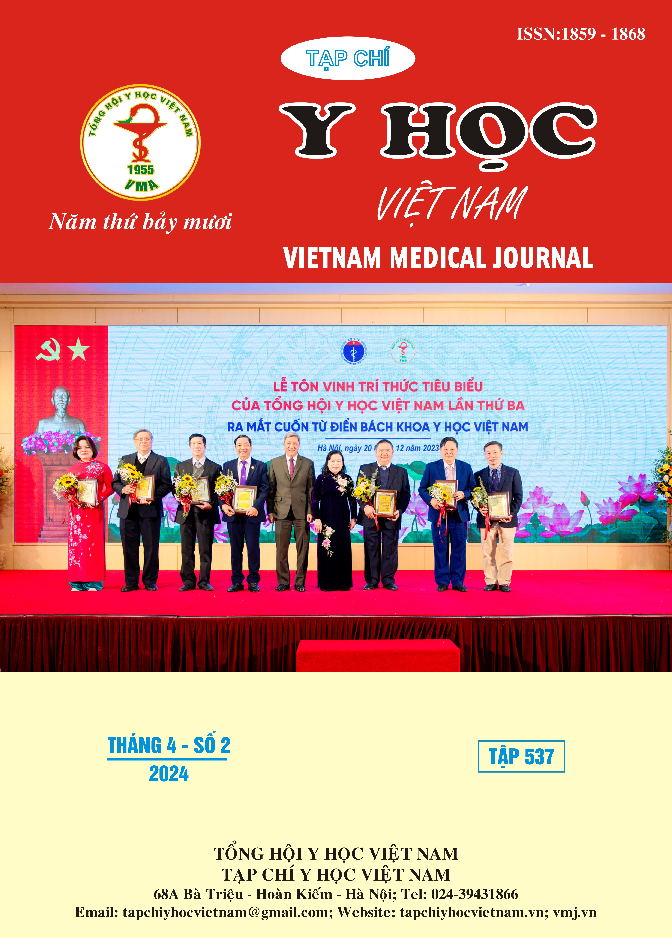COMPARISON OF OUTCOMES BETWEEN ULTRASONIC SURGERY AND TRADITIONAL TOOTH EXTRACTION METHODS FOR LOWER WISDOM TOOTH SURGERY AT MILITARY HOSPITAL 103
Main Article Content
Abstract
Objectives: This study aimed to compare the outcomes of lower wisdom tooth surgery classified as Parant II and III, using an ultrasonic surgery machine versus the traditional tooth extraction method at Military Hospital 103. Subjects and Methods: This descriptive study combined with a longitudinal follow-up and analysis involved 138 patients who underwent lower jaw wisdom tooth surgery classified as Parant II or III at the Department of Oral and Dental of Military Hospital 103 from September 2019 to May 2020. The patients were divided into two groups: normal extraction and mechanical extraction, with 69 patients in each group. Surgical time, pain, swelling, mouth opening, and complications were compared between the two groups. Results: The average surgical time for the machine-assisted group (40.80 ± 2.02 minutes) was longer than that for the traditional tooth extraction group (37.40 ± 2.13 minutes). Patients in the machine-assisted group experienced less pain than those in the traditional extraction group on the first and second days after surgery. Swelling was less pronounced, and mouth opening was better in the machine-assisted group compared to the non-assisted group on the 2nd and 7th days after surgery. Uncommon surgical complications (85.5%) included root fractures (5.8%), flap tears (5.1%), and alveolar fractures (2.2%). Conclusion: Surgery for lower jaw wisdom tooth extraction using an ultrasonic machine, despite a longer operation time, yielded superior results compared to conventional tooth extraction methods.
Article Details
Keywords
Mandibular wisdom teeth, treatment outcomes, ultrasonic tooth extraction.
References
2. Phan Văn Hữu (2011). Ảnh hưởng của vạt bao và vạt tam giác đối với phẫu thuật răng khôn hàm dưới. Y Học TP. Hồ Chí Minh, 2(15): 201-207.
3. Angelo Troedhan, Andreas Kurrek, Marcel Wainwright (2011). Ultrasonic piezotome surgery: is it a benefit for our patients and does it extend surgery time? A retrospective comparative study on the removal of 100 impacted mandibular 3rd molars. Open Journal of Stomatology, 1(4): 179-184.
4. FN Bartuli, F Luciani, F Caddeo, et al. (2013). Piezosurgery vs High Speed Rotary Handpiece: a comparison between the two techniques in the impacted third molar surgery. ORAL & implantology, 6(1): 5.
5. Luigi Piersanti, Matteo Dilorenzo, Giuseppe Monaco, et al. (2014). Piezosurgery or conventional rotatory instruments for inferior third molar extractions? Journal of Oral and Maxillofacial Surgery, 72(9): 1647-1652.
6. Văn Thị Sóc Nâu, Trần Thị Phương Đan, Lâm Nhựt Tân và cộng sự (2022). Kết quả điều trị răng khôn hàm dưới liên quan đến thần kinh răng dưới bằng phẫu thuật có sử dụng máy Piezotome tại bệnh viện trường đại học y dược Cần Thơ. Tạp chí Y Dược học Cần Thơ, 55: 193-200.
7. Antonio Barone, Simone Marconcini, Luca Giacomelli, et al. (2010). A randomized clinical evaluation of ultrasound bone surgery versus traditional rotary instruments in lower third molar extraction. Journal of oral and maxillofacial surgery, 68(2): 330-336.
8. Nguyễn Minh Khởi (2019), Nghiên cứu đặc điểm lâm sàng, X quang và đánh giá kết quả nhổ răng khôn hàm dưới bằng tay khoan quay và máy Piezotome tại Bệnh viện Trường Đại học Y dược Cần Thơ, Luận Văn Thạc Sĩ Y học, Trường Đại học Y Dược Cần Thơ, Cần Thơ.
9. Nguyễn Thị Sen, Lê Xuân Hùng (2021). Đánh giá kết quả phẫu thuật răng khôn hàm dưới tại Bệnh viện Đại học Y Thái Bình. Tạp chí Y học cộng đồng, 62(5(2021)): 141.


